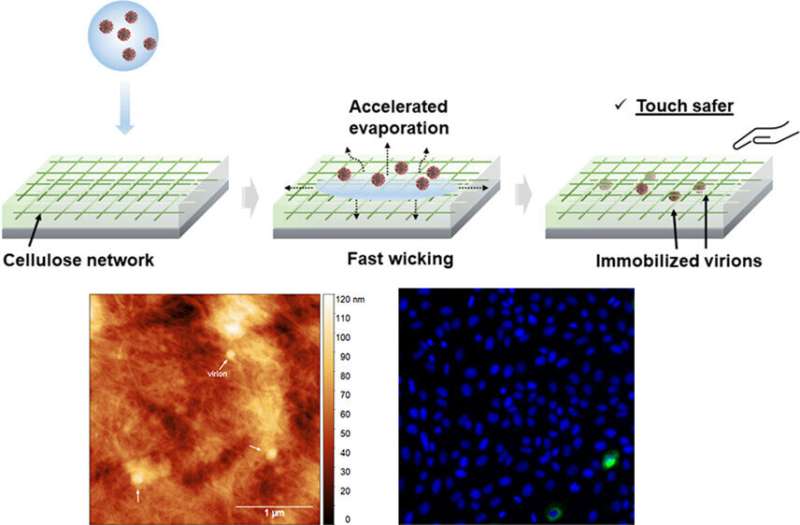This article has been reviewed according to Science X's editorial process and policies. Editors have highlighted the following attributes while ensuring the content's credibility:
fact-checked
peer-reviewed publication
trusted source
proofread
The 'invisible' cellulose coatings that mitigate surface transmission of pathogens

Research has shown that a thin cellulose film can inactivate the SARS-CoV-2 virus within minutes, inhibit the growth of bacteria including E. coli, and mitigate contact transfer of pathogens.
The coating consists of a thin film of cellulose fiber that is invisible to the naked eye, and is abrasion-resistant under dry conditions, making it suitable for use on high traffic objects such as door handles and handrails.
The coating was developed by scientific teams from the University of Birmingham, Cambridge University, and FiberLean Technologies, who worked on a project to formulate treatments for glass, metal or laminate surfaces that would deliver long-lasting protection against the COVID-19 virus.
While conventional chemical disinfectants and antiviral surface designs target either the structural proteins or nucleic acids, the researchers, led by Professor Zhenyu Jason Zhang, from Birmingham's School of Chemical Engineering, focused on drying out the respiratory droplets that contain the viruses by the capillary force introduced by the porous structure.
The COVID-19 virus is known to remain active for several days on surfaces such as plastic and stainless steel, but for only a few hours on newspaper. The team, which has expertise in surface chemistry and formulation engineering, investigated the structure and performance of a coating made from micro-fibrillated cellulose (MFC) provided by FiberLean Technologies, the leading global producer of MFC for the paper and packaging industry.
The researchers found that the porous nature of the film plays a significant role: it accelerates the evaporation rate of liquid droplets, and introduces an imbalanced osmotic pressure across bacteria membrane.
They then tested whether the coating could inhibit surface transmission of SARS-CoV-2. Here they found a three-fold reduction of infectivity when droplets containing the virus were left on the coating for 5 minutes, and, after 10 minutes, the infectivity fell to zero.
By contrast when droplets containing SARS-CoV-2 were left on a glass surface, their initial infectivity was still maintained after 10 minutes. The antimicrobial tests were repeated with droplets containing bacteria (E. coli and S. epidermidis), and here again, the researchers saw substantial reductions in infectivity at 1 hour and 24 hours.
The experiments were repeated with aerosolized artificial saliva, and here the analysis suggested that the cellulose thin film is also effective in suppressing the contact transfer of respiratory aerosols.
Professor Zhang commented, "The risk of surface transmission, as opposed to aerosol transmission, comes from large droplets which remain infective if they land on hard surfaces, where they can be transferred by touch. This surface coating technology uses sustainable materials and could potentially be used in conjunction with other antimicrobial actives to deliver a long-lasting and slow-release antimicrobial effect."
The researchers confirmed the stability of the coating by mechanical scraping tests, where the coating showed no noticeable damage when dry, but easy removal from the surface when wetted, making it convenient and suitable for daily cleaning and disinfection practice.
The paper is published in the journal ACS Applied Materials & Interfaces.
More information: Shaojun Qi et al, Porous Cellulose Thin Films as Sustainable and Effective Antimicrobial Surface Coatings, ACS Applied Materials & Interfaces (2023). DOI: 10.1021/acsami.2c23251
Journal information: ACS Applied Materials and Interfaces
Provided by University of Birmingham





















